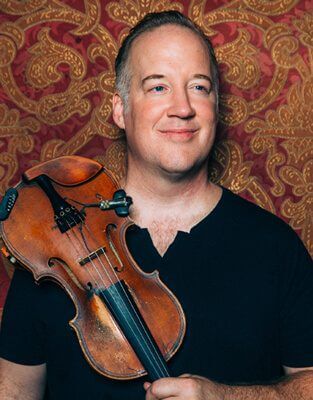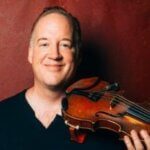On January 23rd, I’ll be playing at Joe’s Pub in NYC as part of composer/guitarist and Guggenheim winner Joel Harrison’s String Choir. The group also features some top creative string players, including Dana Leong, Liberty Ellman, Mat Maneri, and Sam Bardfeld. We’ll be taking on Joel’s arrangement’s of tunes by legendary jazz drummer Paul Motian. Said the New York Times in a recent article, “There’s a lot of collective improvising in [Harrison’s] versions, but when the strings play a theme, strong and coordinated, you can hear these abstract, shrinking-from-light little tunes in boldface and know how well built they always were.”
For string players who want a shot at playing this kind of music, Joel will likely be teaching this year at my annual Creative Strings Workshop.
Joel is one of the most prolific and creative composers writing specifically for strings in the nebulous crossover territory between classical and jazz. Project after project, he finds ways to incorporate blue-chip NYC jazz rhythm section players alongside improvising violinists, violists, and cellists. His music requires string players to be adept not only in improvised traditions, but classical playing as well.
Joel Harrison’s String Choir (check out the record The Music of Paul Motian) further ups the ante, as the accompanying “rhythm section” is made up of two guitars. There’s an inherent challenge in bringing together guitarists and orchestral string players, without any drums, to groove, play ensemble, and improvise collectively with a unified sound.
With lots of through-composed music and frequent demands for subtle group improvisation, it required all of us in the string quartet to find the right balance between expressive improvisation and group cohesion.
Check out the videos from our live performance at Merkin Hall, and some clips from The Music of Paul Motian.
Drum Music (clip)
Misterioso (clip)
Owl of Cranston (clip)
From Time to Time (clip)
Interview with Joel
CH: What skills do you think an ideal “creative string player” needs to have together for playing and interpreting your music?
JH: Good intonation, a strong sense of identity in improvising in a variety of styles, reading skills, good tone production, a sense of what it means to play with a drummer, and without a drummer, and keep a groove either way. Also great to have experience with Appalachian and African music along with jazz and classical tradition. If you can add Indian music to that, YOU ARE HIRED!
CH: Have you encountered any typical problems or limitations working with classical string players? How about “jazz string players”?
JH: If classical players are simply asked to do what they do best, it is not a problem. I do find that they tend to rely on heavy vibrato and are not used to being funky. I think it’s important to not expect a classical player to improvise well. You shouldn’t put them in a position of feeling ill at ease. There is wisdom in having some improvisers and some non-improvisers together, as they can “carry” each other. Jazz players tend to not know as much as classical players about intonation, tone production, and inter-string dynamics. It is very hard to have skills in both the both the improvising and classical worlds, but I hope it is the wave of the future.
CH: Why NYC? Should jazz violinists and cellists move to NYC, and if so, what can they expect to encounter, both good and bad?
JH: In my opinion it is virtually impossible to have a jazz career anywhere but NYC. Furthermore, there is room for string payers there, whereas there are already a million saxophonists. The list of people I can call as subs is pretty small when Chris is not available!
CH: Is there anything that your music, or music of the future, requires of string players that they currently are unable to do?
JH: So far, no. I asked the string players on The Wheel, as well as The String Choir, to do a huge range of things. If you add my classical writing to that, I have pushed the envelope pretty far. I do think that the violin is an amazing groove instrument. Folk traditions utilise this aspect far more than classical or jazz. That is why I try placing the string smack in the middle of the rhythm section sometimes. One must have a sensitive drummer for this.
CH: What types of experience or practice would you recommend to improvising cellists, violinists, and/or viola players in order for them to work at the high standards of musicianship found in your ensembles?
JH: Listen and practice all kinds of music and don’t get caught up in perceived limitations. Practice the Bartok sonata, and then play some raging bebop, and then some funk, and then throw in some Tommy Jarrell. Don’t be nice, be funky, be passionate, break your bow hairs, and check out the whole world of music, not just America. Don’t forget, though that if your tone sucks and you play out of tune, no one will care much how great a solo you play! Slow and beautiful beats fast and ugly every time unless it is punk rock.
Creative Strings Workshop
Joel Harrison is a likely teacher for this year’s Creative Strings Workshop, June 21-26, 2011 in Columbus, OH. Participants will get a chance to explore some of his vastly diverse projects, as well as learn from some of the other leading strings innovators from around the world (click to learn about and register for this year’s Creative Strings Workshop).







